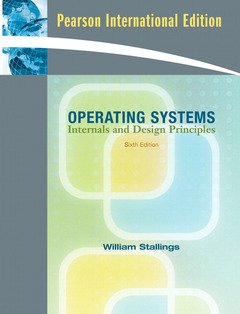Description
Operating systems: Internals & design principles (6th Ed.)
Author: STALLINGS William
Language: English
Subjects for Operating systems: Internals & design principles :
Approximative price 82.80 €
Subject to availability at the publisher.
Add to cart832 p. · Hardback
Description
/li>Contents
/li>
WEB SITE FOR OPERATING SYSTEMS, INTERNALS AND DESIGN PRINCIPLES
PREFACE CHAPTER 0 READER'S GUIDE0.1 Outline of the Book
0.2 Topic Ordering
0.3 Internet and Web Resources
PART ONE BACKGROUND Chapter 1 Computer System Overview1.1 Basic Elements
1.2 Processor Registers
1.3 Instruction Execution
1.4 Interrupts
1.5 The Memory Hierarchy
1.6 Cache Memory
1.7 I/O Communication Techniques
1.8 Recommended Reading and Web Sites
1.9 Key Terms, Review Questions, and Problems
Appendix 1A Performance Characteristics of Two-Level Memory
Appendix 1B Procedure Control
Chapter 2 Operating System Overview2.1 Operating System Objectives and Functions
2.2 The Evolution of Operating Systems
2.3 Major Achievements
2.4 Characteristics of Modern Operating Systems
2.5 Windows Vista Overview
2.6 Traditional UNIX Systems
2.7 Modern UNIX Systems
2.8 Linux
2.9 Recommended Reading and Web Sites
2.10 Key Terms, Review Questions, and Problems
PART TWO PROCESSES Chapter 3 Process Description and Control3.1 What is a Process?
3.2 Process States
3.3 Process Description
3.4 Process Control
3.5 UNIX FreeBSD Process Management
3.6 Summary
3.7 Recommended Reading
3.8 Key Terms, Review Questions, and Problems
Programming Project 1 Developing a Shell Chapter 4 Threads, SMP, and Microkernels4.1 Processes and Threads
4.2 Symmetric Multiprocessing (SMP)
4.3 Microkernels
4.4 Windows Vista Thread and SMP Management
4.5 Solaris Thread and SMP Management
4.6 Linux Process and Thread Management
4.7 Summary
4.8 Recommended Reading
4.9 Key Terms, Review Questions, and Problems
Chapter 5 Concurrency: Mutual Exclusion...These books may interest you

Linux Essentials 38.40 €



